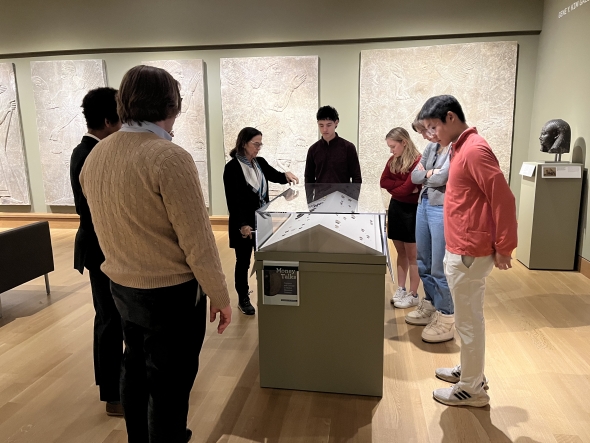Exploring Ancient Histories through Roman Coins: Organized by '26 Gideon Gruel
As part of the Hanlon Scholars cohort programming, students are encouraged to design research-sharing events in their junior or senior years, working closely with their faculty mentors to share insights with their peers. Gideon Gruel '26 took advantage of this opportunity to organize an event that led him to a fascinating exploration of Roman coins as a unique medium for understanding ancient histories, values, and beliefs.
Gideon's academic interests, which encompass Ancient History, Classical Languages, and Philosophy—with a particular focus on Roman religion—naturally led him to explore Roman numismatics. For his Hanlon Scholars research project, titled "Interfaith (In)Tolerance: Religious Coexistence and Conflict in the Late Antique Roman Empire," Gideon collaborated closely with his faculty mentor, Professor Roberta Stewart, a Classics professor with expertise in Roman history. Although the idea for his event originated before he took Professor Stewart's Ancient Coins as Text course in the fall of 2024, Gideon recognized that the class would deepen his understanding of the topic. Motivated by both his academic research and the upcoming course, he envisioned an event that would connect his growing knowledge of Roman numismatics with his broader research goals, offering his peers a unique opportunity to engage with the intersection of ancient history, religion, and material culture.
Gideon proposed an event centered around the study of Roman coins, highlighting their role in uncovering aspects of ancient societies that are not easily accessible through written records alone. As he explained, "The study of ancient history engages a body of work from the Classical world that is severely curtailed: we only have a small fraction of the written record that once existed in the books and minds of ancient Greeks and Romans. To supplement the surviving written corpus, Classicists often turn to material culture, of which coins comprise an important facet. Ancient coins offer independent snapshots of ancient cultures, their values, their beliefs, their worries, and even their humor, in a way that even the priceless remnants of Livy or Tacitus cannot do."
Gideon_Roman_Coins_Presentation

The event took place at the Hood Museum of Arts and Sciences, where Hanlon Scholars had the rare opportunity to view ancient Roman coins from the museum's extensive collection. Randall Kuhlman, the room attendant at the Bernstein Center for Object Study, guided the group through the experience. Gideon kicked off the event by sharing a selection of Roman coins he had studied in Professor Stewart's coin course. He invited his fellow scholars to explore the recurring symbols and imagery on the coins, prompting them to reflect on how these elements influenced the public perception of Caesar's empire. These coins provided tangible examples of the types of historical insights that could be drawn from the study of coins. Following Gideon's presentation, Professor Stewart guided the group in an investigation of three particular coins, each with its own unique story and political purpose.
Hanlon Scholars Roman Coins Exploration

The event culminated with Professor Stewart guiding the scholars through the exhibit she had curated at the Hood Museum, titled Money Talks. This installation challenged traditional understandings of currency by examining its cultural significance across different societies. Drawing on examples from various times and places, the exhibit invited the audience to reflect on the purpose of money beyond its simple role in commerce.
Professor Stewart Roman Coins Exhibit

Afterward, the scholars also enjoyed a reception in the museum atrium, which provided a great opportunity to mingle, discuss ideas, and further reflect on the event's themes. The event not only deepened the students' understanding of the Roman Empire but also illustrated the role of numismatics in uncovering historical narratives. By examining these ancient artifacts, scholars were able to piece together stories from a pivotal moment in Roman history—the later stages of the Civil War when Julius Caesar was consolidating power. The experience offered an insightful and enriching look at the fascinating world of ancient coins and their relevance in studying the past.